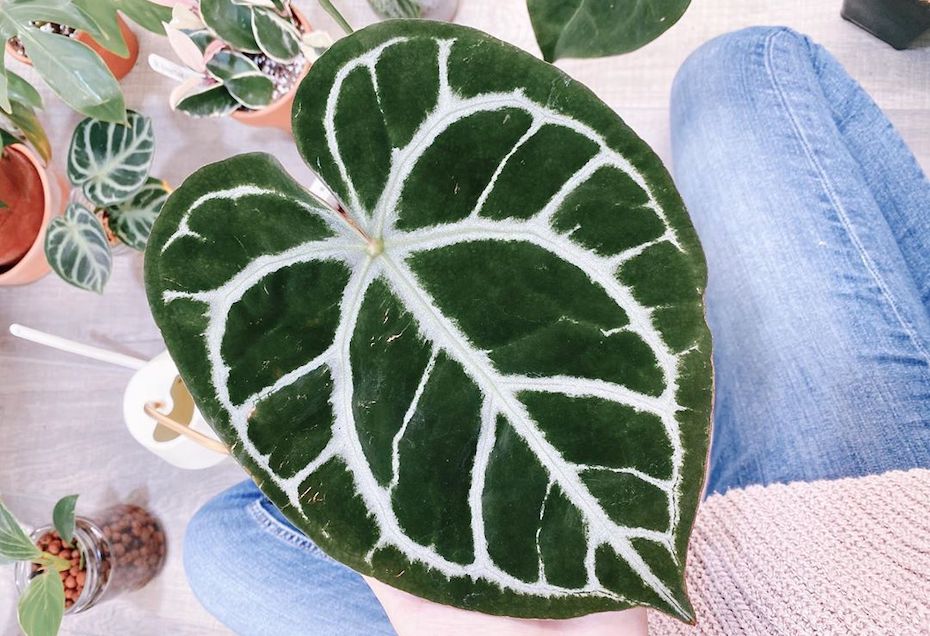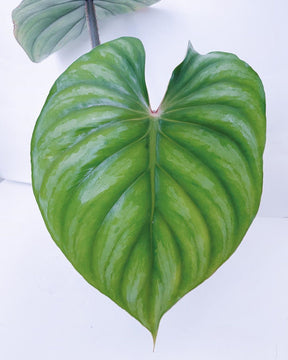Anthurium Crystallinum Care Guide - Tips for Optimal Growth
 Anthurium Crystallinum: @RootedHues
Anthurium Crystallinum: @RootedHues
Native to Central and South America, the anthurium crystallinum is a heart-shaped evergreen with velvety foliage. The leaves of this beauty are dark green or reddish purple with deep, white veins that make it visually stand out. Anthuriums are widely enjoyed as outdoor plants in tropical gardens, but they also make excellent houseplants in the kitchen, patio, or living room. The good news is, you don’t have to live in the tropics to enjoy this attractive evergreen. With a little care and attention, you can grow your own anthurium crystallinum at home - as you’re about to find out here!
Quick Overview of Anthurium Crystallinum
- Other name: Crystal anthurium
- Light: Full sun, partial shade
- Temperature: Between 60-70 degrees Fahrenheit.
- Humidity: Anthurium thrives in high humidity but requires adequate air circulation. In dry or hot climates, mist the leaves daily.
- Watering: During the growing season, keep the soil moist at the top by watering every few days. In summer, the plant needs more water than any other season (up to 4 times a week). In humid conditions, however, it can go without water for up to two weeks
- Growth and Size: 0.5 meters every 2-5 years. The leaves can grow up to 90 cm (60 inches).
- Pruning: Prune from the top down and remove the dead or discolored leaves regularly.
- Soil: Sand, sphagnum moss, and pine bark, or coconut coir mixed with peat moss.
- Propagation: Propagate by seed at 70 to 75 degrees Fahrenheit. March is the best time to start propagating this durable evergreen.
- Fertilizer: Use organic, slow release fertilizer in spring. For flower growth, make sure the fertilizer contains phosphorus as well as nitrogen and magnesium.
- Repotting: Required every 2 years. Best done in spring, summer, or early fall.
- Pests: Mealy bugs, scale, and aphids. Sprinkle them off with a little water.
- Is it Poisonous? Yes. We know it’s leafy green, but it doesn’t belong in your salad! All parts are poisonous if ingested. The sap can irritate the skin. To keep your pets or children safe, place the plant on a high shelf out of their reach.
When and How to Grow Anthurium Crystallinum
The best time to plant is in the Spring. The best place to start growing your anthurium is in the kitchen or bathroom as these are the rooms with the highest humidity levels. The seed’s crown should be just above the soil surface, with enough moss to prevent the roots from drying out.
Pro Tip: If you’re starting from seed or root, use the jar trick to create optimal humidity. Simply place a jar over the root or seed to create humid air.
Maintain a constant temperature of min. 60 degrees Fahrenheit and water generously during the growing season. Lastly, don’t forget to apply a balanced amount of organic liquid fertilizer. Your anthurium should begin germination within 7 days, depending on the humidity level of the room.
3 Other Anthurium Varieties We Love
-
Clarinervium: This anthurium variety is quite rare to find, but we won’t stop looking! Native to New Mexico, the leaves of this plant are large and oval shaped with white veins just like the crystallinum.
-
Magnificum: Another exotic breed of anthurium is the magnificent magnificum. It’s a native of Columbia and surprisingly blooms all year round! This is hardly surprising as the flowers are bisexual!
- Superbum: A native of Ecuador, the superbum variety is packed with attitude! Dare we say its dark purple elliptical leaves look somewhat prehistoric but nevertheless stunning.
Anthurium Crystallinum vs. Clarinervium
The clarinervium is a close relative of crystallinum. While these two types of anthuriums do have some similarities in terms of their leaf size and shape, the crystallinum produces violet and white berries whereas its cousin produces large and juicy orange berries.
Anthurium Crystallinum Common Problems
- Problem: My anthurium crystallinum is suffering from fungal disease.
-
Solution: Fungal diseases are the most common problem in anthuriums. These diseases can rot the stem and root of the plant as well as damage the leaves. However, this problem can be prevented by avoiding excessive watering. For severe bacterial problems, you can use fungicide to prevent the disease from spreading to the rest of the plant.
- Problem: Why are the leaves on my crystallinum turning yellow?
-
Solution: Low indoor air humidity is the main cause of brown leaves and dead ends. This is an indication that the plant is dying. If your room lacks humidity, water the plant more often.
- Problem: I can see brown leaves and dead ends on my crystallinum.
- Solution: This is the first sign of overwatering. Only water the plant when the soil feels dry. The yellow leaves may also be due to direct sunlight. Make sure the plant stays in the shade when the sunlight is too intense (usually in the afternoons).
As you can see, anthuriums don’t require much care as long as you provide them with the right indoor temperature and keep pests at bay. These plants thrive in humid conditions, and if you are consistent with your pruning and watering, they will produce beautiful flowers periodically throughout the year!
Written byRashin Rohanifar

















